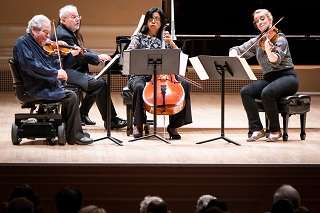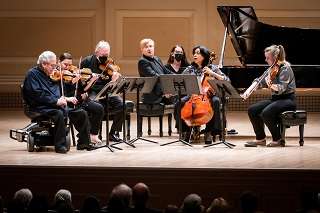|
Back
When is the time to say goodbye? New York
Carnegie Hall, Isaac Stern Auditorium, Ronald O. Perelman Stage
12/14/2022 -
Jean‑Marie Leclair: Sonata for Two Violins in E Minor, op.3 No.5 (+)
Wolfgang Amadeus Mozart: Piano Quartet in E flat Major, K.493
Ernest Chausson: Concert for Violin, Piano and String Quartet, op.21 (*)
Itzhak Perlman (Violin), Emanuel Ax, Jean‑Yves Thibaudet (*) (Piano), Juilliard String Quartet: Areta Zhulla (+), Ronald Copes (violin), Molly Carr (viola), Astrid Schweem (cello)

I. Perlman, E. Ax, A. Schweem, M. Carr (© Chris Lee)
For the last two decades, Carnegie Hall devotes one winter evening to the chamber music event with a star‑studded cast and such concert is called The Annual Isaac Stern Memorial Concert, dedicated to the memory of a great artist, famed violinist and cultural icon known to many as a person who, in 1960 saved the building of Carnegie Hall from demolition.
Those yearly concerts usually present artists that in the past were connected to Mr. Stern and in that respect, the last event was no different. As a teenager, Itzhak Perlman was brought to the United States from Israel upon the recommendation of Mr. Stern and the paths of those two musicians have been interconnected ever since. In the 1980’s, pianist Emanuel Ax, by connection to Yo‑Yo Ma and other leading string players of that era, came into contact with Mr. Stern and frequently performed and recorded with him. In the most recent concert, Jean‑Yves Thibaudet was the only musician who didn’t have a tight relationship with Mr. Stern. This legacy extended to the string players from the equally famed Juilliard String Quartet who were connected both as students and associates of Mr. Perlman who in ,he last few decades became an active teacher and mentor to many nascent virtuosi., just as Mr. Stern was a generation earlier.
During the program, Mr. Perlman was present on stage, riding his electric vehicle, throughout the evening performing in all three works, while the two larger compositions by Mozart and Chausson alternated between two magnificent pianists. Mr. Thibaudet is considered nowadays one of the most formidable interpreters of French music, solo and chamber, and Mr. Ax, more than a decade older, still excels in classical repertory; thus, entrusting him with the piano part in Mozart Quartet was an appropriate choice. That is not to say that Mr. Ax would not be up to the French music task, as I remember him more than three decades ago on the same stage playing Chausson’s difficult work. The only difference now is that we have names given to the auditorium (now named after Mr. Stern) and its stage (now bearing that glorious title “Ronald O. Perelman Stage”). Those good old days, when the stage was just a stage...
The task of a reviewer is generally speaking an act of providing a report on the event (factual) with his/her own commentaries (strictly personal and far removed from any resemblance to objectivity). There are sometimes events when the scribe is torn, in doubt, at the crossroads. How do you evaluate a concert of a legendary performer – and Mr. Perlman, as only a few of his contemporaries have achieved that status – when it is painfully evident that our adored artist is but a shadow of his old self?
That is not to dismiss Mr. Perlman’s abilities as a violinist: in the moderately virtuosic Sonata in E Minor for Two Violins (1730) by Leclair, his agility was still evident and, together with Areta Zhulla, his former student and now a leader of the Juilliard Quartet, he navigated through the three short, charming movements without a strain.
Next came the Mozart Quartet in E Flat for piano, violin, viola and cello (1786) and Mr. Perlman’s sound didn’t seem to match either the piano or the other string instruments. By that I am not implying that Mr. Ax was too loud: as a chamber musician, he was and is always a model of careful and considered partner, and the two other strings were always able to shine through.
As much as all instrumentalists’ contributions were valuable, this work features mostly the piano and here Mr. Ax’s pearly yet assertive playing was a joy to hear. There was transparency and clarity, beautiful sound and phrasing, and an innate understanding of style. I was especially pleased that Mr. Ax allows himself to subtly ornament the original melodic line, something that the composer would have also done. In the moments when the violin part would be audible, Perlman’s sound was still sweet and lovely but still remained a bit undernourished.
It is not hard to understand why this quartet – as the earlier one, in G Minor – was in Mozart’s time deemed unplayable for the “music buying public”: in too many places, especially in the Finale, the piano part has all the characteristics of a piano concerto, with quick runs all over the keyboard which were obviously nothing for a virtuoso such as Mr. Ax or previously for Mozart himself. Mozart soon abandoned the thought of continuing that genre which he invented and we are all, pianists and listeners, far poorer for it.

I. Perlman, A. Zhulla, R. Copes, J.‑Y. Thibaudet, A. Schweem, M. Carr (© Chris Lee)
The second part of the concert was devoted to one work, Ernest Chausson’s Concert for Violin, Piano and String Quartet (1889‑1891) and there the already observed instrumental imbalance was even more pronounced. The Chausson is a long work, 42 minutes in duration, in four movements demanding instrumental virtuosity from all six instruments. Its title is a bit of a misnomer. First of all one may wonder why Chausson used the French name rather than Italian (Concerto). But is it even a work that should be named concerto if there is a total unity of all instruments, even though the quartet often accompanies the two main instruments? One could also name it “Duet for Violin and Piano with accompanying string quartet” except that the quartet sometimes takes almost an equal role when all six instruments project evenly. Apparently, Chausson even called the main instruments “projections against a quartet background”.
A very skeptical and unsure-of-himself composer declared it a “dismal failure” until the famous violinist Eugčne Ysa˙e, pianist Auguste Pierret and Ysa˙e’s own quartet premiered the Concert in Brussels in 1892 and it became a huge success. It is an amazing, emotionally charged, meticulously constructed composition full of instrumental color and virtuosity. This music forms an elegant, if swaying, bridge between Franck’s lush Piano Quintet, Wagnerian romanticism all the way to Fauré and later the sensuous impressionist language of Debussy.
We were fortunate to have Jean‑Yves Thibaudet at the piano: it is not only that he has internalized the style of French late Romantics and excels, as a soloist, in works of Saint‑Saëns, Debussy, Satie or Ravel to name just a few, but he possesses this effortless technique which permits him to conquer one of the most difficult parts in the repertory of this era. The listener had a feeling that Thibaudet simply owns this part and plays with it according to his whims. It was a virtuoso approach to a virtuoso part yet I didn’t feel that the pianist was overplaying: after all he is also a fabulous chamber musician. Thus it was even more jarring than in Mozart’s Quartet, that Mr. Thibaudet didn’t have an equal partner in Mr. Perlman whose strength was just not sufficient to the demands of the score. When we needed a large, lustrous, penetrating sound, we barely heard the violin and as the piece progressed, the violin sound got weaker: one could sense that Mr. Perlman was getting tired.
It was perhaps even more disconcerting when this listener had still in his ears the same work being performed by the same violinist a few decades back with the late Jorge Bolet at the piano and the same Juilliard Quartet, albeit in its much older lineup. It’s worth adding that this time the artists dedicated their performance to the memory of its beloved member of Juilliard Quartet, the violist Roger Tapping who passed on January 18, 2022.
With all my quibbles regarding the violin part, everyone else was excellent and we heard an impassioned, taut, and enthusiastic rendition of that impressive composition. The two middle movements are less forceful than the stormy outer ones: the gentle “Sicilienne” sways in 6/8 meter and alternates tonality between minor and major, whereas the “Grave” has almost a tragic character. Here one could admire the intensity and beauty of sound among all six instruments. Incidentally, I found the collective sound of the Juilliard Quartet now as more opulent, richer, and of better quality than even the last decade. New, younger members obviously meant a new approach and renewed instrumental excellence. Bobby Mann, the founder of the Quartet in 1946 must be smiling from above that his creation survived him.
At the end we were still left with the question: are the pieces as challenging as the Chausson Concert the best vehicle for Mr. Perlman at this point of his career and his physical strengths? Even though his playing is not getting any better – and that’s being put in the most gracious terms – he still enjoys enormous popularity, due to the long and fantastic career and stage charisma. He still sells out the venues where he performs, and ticket prices for his performances hold very high, too. But does it make sense for him, with the strength of his bow arm, and thus the sound, diminishing, to appear in venues as large as Carnegie Hall? Just asking... Leaving Carnegie Hall, I could not help but to think of Alfred Brendel who bravely decided to leave the concert stage while he was still in nearly full command of his pianistic might. Should Mr. Perlman by chance take a hint?
Roman Markowicz
|